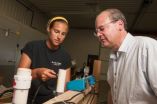Karate experts are able to generate extremely powerful forces with their punches, but how they do this is not fully understood. Previous studies have found that the force generated in a karate punch is not determined by muscular strength, suggesting that factors related to the control of muscle movement by the brain might be important.
The study, published in the journal Cerebral Cortex, looked for differences in brain structure between 12 karate practitioners with a black belt rank and an average of 13.8 years' karate experience, and 12 control subjects of similar age who exercised regularly but did not have any martial arts experience.
The researchers tested how powerfully the subjects could punch, but to make useful comparisons with the punching of novices they restricted the task to punching from short range – a distance of 5 centimetres. The subjects wore infrared markers on their arms and torso to capture the speed of their movements.
As expected, the karate group punched harder. The power of their punches seemed to be down to timing: the force they generated correlated with how well the movement of their wrists and shoulders were synchronised.
Brain scans showed that the microscopic structure in certain regions of the brain differed between the two groups. Each brain region is composed of grey matter, consisting of the main bodies of nerve cells, and white matter, which is mainly made up of bundles of fibres that carry signals from one region to another. The scans used in this study, called diffusion tensor imaging (DTI), detected structural differences in the white matter of parts of the brain called the cerebellum and the primary motor cortex, which are known to be involved in controlling movement.
The differences measured by DTI in the cerebellum correlated with the synchronicity of the subjects' wrist and shoulder movements when punching. The DTI signal also correlated with the age at which karate experts began training and their total experience of the discipline. These findings suggest that the structural differences in the brain are related to the black belts' punching ability.
"Most research on how the brain controls movement has been based on examining how diseases can impair motor skills," said Dr Ed Roberts, from the Department of Medicine at Imperial College London, who led the study. "We took a different approach, by looking at what enables experts to perform better than novices in tests of physical skill.
"The karate black belts were able to repeatedly coordinate their punching action with a level of coordination that novices can't produce. We think that ability might be related to fine tuning of neural connections in the cerebellum, allowing them to synchronise their arm and trunk movements very accurately.
"We're only just beginning to understand the relationship between brain structure and behaviour, but our findings are consistent with earlier research showing that the cerebellum plays a critical role in our ability to produce complex, coordinated movements.
"There are several factors that can affect the DTI signal, so we can't say exactly what features of the white matter these differences correspond to. Further studies using more advanced techniques will give us a clearer picture."
INFORMATION:
The study was supported by the Medical Research Council (MRC), the Wellcome Trust, and the National Institute for Health Research (NIHR) Biomedical Research Centre at University College London Hospitals NHS Foundation Trust and University College London.
For further information please contact:
Sam Wong
Research Media Officer
Imperial College London
Email: sam.wong@imperial.ac.uk
Tel: +44(0)20 7594 2198
Out of hours duty press officer: +44(0)7803 886 248
Notes to editors
1. Reference: RE Roberts et al. 'Individuals differences in expert motor coordination associated with white matter microstructure in the cerebellum.' Cerebral Cortex, 15 August 2012. doi:10.1093/cercor/bhs219
2. Download a colour image showing the locations in the cerebellum and motor cortex where there were differences between the groups: https://fileexchange.imperial.ac.uk/files/a0c7ebdb91/CEREBELLUM_MOTOR_CORTEX_COLOUR.png
3. About Imperial College London
Consistently rated amongst the world's best universities, Imperial College London is a science-based institution with a reputation for excellence in teaching and research that attracts 14,000 students and 6,000 staff of the highest international quality. Innovative research at the College explores the interface between science, medicine, engineering and business, delivering practical solutions that improve quality of life and the environment - underpinned by a dynamic enterprise culture.
Since its foundation in 1907, Imperial's contributions to society have included the discovery of penicillin, the development of holography and the foundations of fibre optics. This commitment to the application of research for the benefit of all continues today, with current focuses including interdisciplinary collaborations to improve global health, tackle climate change, develop sustainable sources of energy and address security challenges.
In 2007, Imperial College London and Imperial College Healthcare NHS Trust formed the UK's first Academic Health Science Centre. This unique partnership aims to improve the quality of life of patients and populations by taking new discoveries and translating them into new therapies as quickly as possible.
Website: www.imperial.ac.uk
Twitter: www.twitter.com/imperialspark
Podcast: www.imperial.ac.uk/media/podcasts
4. About the NIHR
The National Institute for Health Research (NIHR) is funded by the Department of Health to improve the health and wealth of the nation through research. Since its establishment in April 2006, the NIHR has transformed research in the NHS. It has increased the volume of applied health research for the benefit of patients and the public, driven faster translation of basic science discoveries into tangible benefits for patients and the economy, and developed and supported the people who conduct and contribute to applied health research. The NIHR plays a key role in the Government's strategy for economic growth, attracting investment by the life-sciences industries through its world-class infrastructure for health research. Together, the NIHR people, programmes, centres of excellence and systems represent the most integrated health research system in the world. For further information, visit the NIHR website.
This article presents independent research funded by the National Institute for Health Research (NIHR). The views expressed are those of the author(s) and not necessarily those of the NHS, the NIHR or the Department of Health.
5. The NIHR Biomedical Research Centre at University College London Hospitals NHS Foundation Trust and University College London was established in 2007 and is at the forefront of research into some of the major causes of illness and disease-related death. The biomedical research centre (BRC), which has invested over £100m in new experimental medicine research projects, staff, equipment and facilities, was last year awarded a further £98million in government funding from the National Institute for Health Research. The BRC focuses on a range of advances in medical research that will have a direct impact on patients' care and quality of life, and will also save many lives. These include advances in the areas of cancer, cardiovascular disease, infectious disease, women's health, oral health and neurological diseases such as epilepsy, stroke and multiple sclerosis.
6. About the Medical Research Council
For almost 100 years the Medical Research Council has improved the health of people in the UK and around the world by supporting the highest quality science. The MRC invests in world-class scientists. It has produced 29 Nobel Prize winners and sustains a flourishing environment for internationally recognised research. The MRC focuses on making an impact and provides the financial muscle and scientific expertise behind medical breakthroughs, including one of the first antibiotics penicillin, the structure of DNA and the lethal link between smoking and cancer. Today MRC funded scientists tackle research into the major health challenges of the 21st century. www.mrc.ac.uk
7. About the Wellcome Trust
The Wellcome Trust is a global charitable foundation dedicated to achieving extraordinary improvements in human and animal health. It supports the brightest minds in biomedical research and the medical humanities. The Trust's breadth of support includes public engagement, education and the application of research to improve health. It is independent of both political and commercial interests. www.wellcome.ac.uk
END



